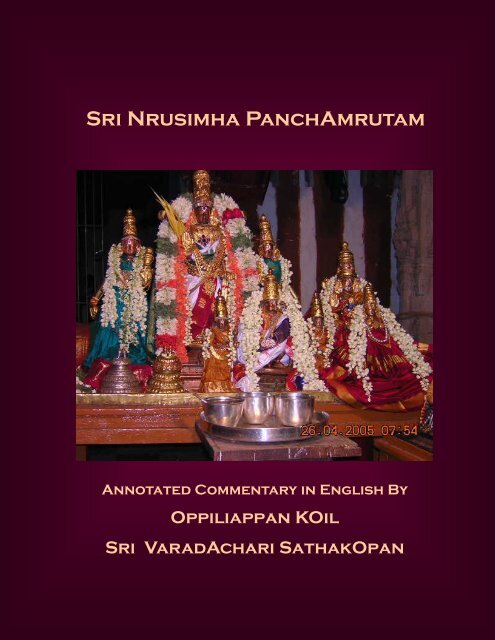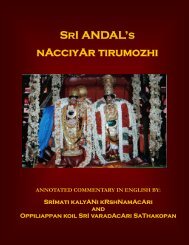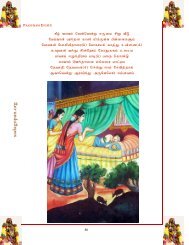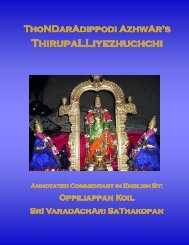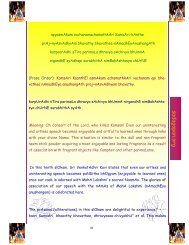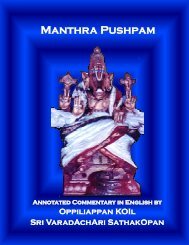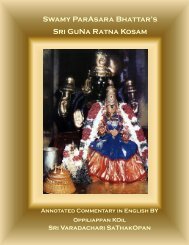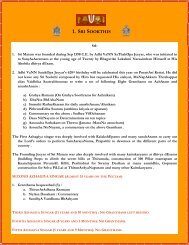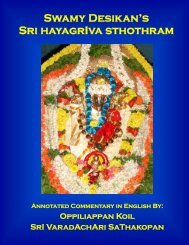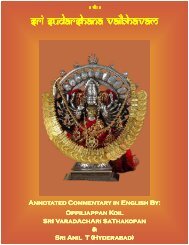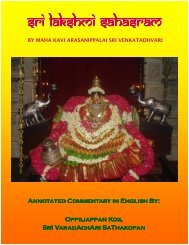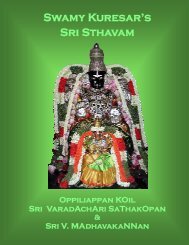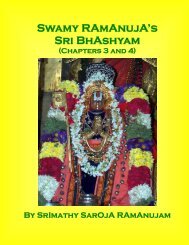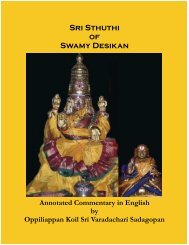Sri Nrusimha PanchAmrutam - Sundarasimham
Sri Nrusimha PanchAmrutam - Sundarasimham
Sri Nrusimha PanchAmrutam - Sundarasimham
Create successful ePaper yourself
Turn your PDF publications into a flip-book with our unique Google optimized e-Paper software.
<strong>Sri</strong> <strong>Nrusimha</strong> <strong>PanchAmrutam</strong><br />
Annotated Commentary in English By<br />
Oppiliappan KOil<br />
<strong>Sri</strong> VaradAchari SathakOpan
sadagopan.org
CONTENTS<br />
1<br />
Page<br />
Introduction 3<br />
Introductory Slokam 4<br />
Slokam 1 5<br />
Slokam 2 10<br />
Slokam 3 12<br />
Slokam 4 13<br />
Slokam 5 15<br />
<strong>Sri</strong> <strong>Nrusimha</strong> Naamaavali 17<br />
Nigamanam 18<br />
sadagopan.org
sadagopan.org<br />
2
. ïI>.<br />
. ïI n&is
sadagopan.org<br />
INTRODUCTORY SLOKAM<br />
. ïI n&is.<br />
SRI NRUSIMHAAYA NAMA:<br />
Ahaeibl< naris àtapvan! ,<br />
nmSk«Tva ïIn&is
AhObilam Naarasimham gathvA Rama: PrathApavAn |<br />
NamaskruthvA SrI <strong>Nrusimha</strong>m asthousheeth KamalApathim ||<br />
In this slokam, <strong>Sri</strong> <strong>Nrusimha</strong>n is described as KamalApathi or the consort of MahA Lakshmi,<br />
who does not leave Him even for a second. Hence, the ArchA murthy worshipped by <strong>Sri</strong><br />
RamA could very well be MaalOlan or Lakshmi Narasimhan, who is the Aaradhana Murthy<br />
of Ahobila Mutt Jeeyars today.<br />
The slokam indicates that <strong>Sri</strong> RamA prostrated first before the Lord of Ahobilam (Kaayika<br />
namaskaraNam) and then offered His vaachika salutation (Asthousheeth).<br />
The first line of this slokam states that the valorous <strong>Sri</strong> RamA (PrathApavAn) made a<br />
deliberate journey to Ahobilam (gathvA) and offered his homage to Lord Narasimhan.<br />
5<br />
sadagopan.org
sadagopan.org<br />
SLOKAM 1<br />
gaeivNd kezv jnadRn vasudev<br />
ivñez ivñ mxusUdn ivñêp ,<br />
ïI pÒnaÉ pué;aeÄm pu:kra]<br />
naray[aCyut n&is ,<br />
SavaRyux> svRzi´> svR}> svRtaemuo> .<br />
Hrudh padmE PadmanAbhO mE sahasrArka samaprabha: |<br />
SarvAyudha: Sarvasakthi: Sarvajn~a: sarvathOmukha: ||<br />
6
“Malolan Sannidhi -Ahobilam”<br />
<strong>Sri</strong> RamA reached Ahobilam to seek the blessings of the Lord, who used just His nails as a<br />
weapon, even though He is served by SarvAyudhams and is the embodiment of Sarva Sakthi.<br />
BhagavAn Narasimhan gave the boon of his sarva sakthi to RamA to complete successfully<br />
His avathAra Kaaryam.<br />
<strong>Sri</strong> RamA’s choice of the naamam “SRI PADMANAABHA” reminds one of the prefix,<br />
Lakshmi, which goes before the name of the Lord of Ahobilam (Lakshmi Narasimhan). One<br />
is also reminded of the consort of the ArchAmurthy of Thiruvananthapuram (PadmanAbhan)<br />
revered as “Hari Lakshmi”.<br />
The twelve names (Dwaadasa Naama) chosen by RamA to construct the golden cage/house<br />
(Panjaram) for BhagavAn of AhObilam are:<br />
1. Govindha (190 th VSN; The protector of those, who know the words)<br />
2. Kesava (23 rd VSN; one who has lovely locks of hair/Pidari)<br />
3. JanArdhana (128 th VSN; the destroyer of persons who are antagonistic)<br />
4. Vaasudeva (334 th VSN; He who pervades and sports)<br />
7<br />
sadagopan.org
sadagopan.org<br />
5. Visvesa (Close to VSN 118 th : Om Visva YonayEa nama:)<br />
6. Visva (full in all aspects, 1 st naamam of VSN)<br />
7. Madhusoodhana (an epithet for VishNu and is also the name for honey bee; RamA’s<br />
sancharam as a Bhramaram (bee) around Bhagavan NarasimhA can also be the<br />
reference).<br />
8. Visvaroopa (close to VSN 89; Om VisvarEthasE Nama:)<br />
9. <strong>Sri</strong> PadmanAbha (48 th VSN; One who has a lotus in His navel)<br />
10. PurushOtthama (24 th VSN)<br />
11. PushkarAksha (40 th VSN; the lotus eyed one)<br />
12. NaarAyaNAchyutha (AchyuthAnandha Govindha NaarayaNa namOsthu tEh).<br />
The remaining four slokams end with the line, “Tham Naarasimham SaraNam gathOsmi” or<br />
“Tvaam <strong>Nrusimha</strong>m sathatham NathOsmi”.<br />
BhagavAn <strong>Sri</strong>ya: Pathi: <strong>Sri</strong>man NaarAyaNa:<br />
BhakthAnAm Abhaya^nkara: Dushta Nigraha<br />
Sishta paripAlana Kshama: saraNAgatha<br />
Vathsala: NaarAyaNAchyutha <strong>Nrusimha</strong>,<br />
Thubhyam NamO Nama:<br />
I referred earlier to the splendid way in which Chakravathi Thirumahan used 12 names to seat<br />
<strong>Sri</strong> MaalOlan in his heart cage in the spirit of DvAdasa Naama Panjara Sthuthi.<br />
One of the unusual combinations of two NaamAs, into one name “NaarAyaNAchyutha” is a<br />
thought provoking usage by <strong>Sri</strong> Rama. This is the 12 th and the last naamA of the first slokam.<br />
The greatness of the name “NaarAyaNa” is celebrated as the elaboration of the first part of<br />
PraNavam (A). The various slokAs of Naaradheeya Kalpam (AshtAkshara Brahma VidhyA)<br />
reveal to us the greatness and the profound significance of NaarayaNa sabdham. It is part of<br />
Moola Manthram. Indeed, it is the most significant part of Moola Manthram. That is why it<br />
is considered as Dharaka -Poshaka - Bhogya Sabdham as the resident of the golden cage of<br />
AshtAkshari. Further, the central doctrines of <strong>Sri</strong> VaishNavAs are the three rahasyams:<br />
AshtAkshari, Dhvayam and Charama Slokam. Our Acharyas and <strong>Sri</strong> RamachandrA’s<br />
Achaarya (Sage VasishtA) have instructed us that one is born in Thirumanthiram, grows in<br />
Dhvayam and ends with Charama Slokam. All of them have at their core <strong>Sri</strong>man<br />
NaarAyaNan. That is why Sage Naaradha states that NaarAyaNA is AshtAkshara Svarupi:<br />
8
vyaktham hi BhagavAn Deva: SakshAnnArAyaNa: Svayam |<br />
AshtAkshara svarupENa mukhEshu parivarthatEh ||<br />
(MEANING):<br />
It is very clear and unquestionable. <strong>Sri</strong>man NaarAyaNan, the treasure house of the six guNAs<br />
such as Jn~anam, Balam, Isvaryam et. al roams in the faces of the reciter of moola manthram<br />
made up of eight aksharAs. This is the glory of NaarAyaNa parAyaNA:<br />
Elsewhere, Sage NaradhA reveals that he has taken refuge in the Manthram celebrating<br />
NaarAyaNa sabdham this way:<br />
AaseenA vaa sayanaa vaa thishtanthO yathra kuthra vaa |<br />
NamO NaarAyaNAyEthi mantraika saraNA vayam ||<br />
(MEANING):<br />
Whether we are seated, resting or standing, whether we are here or there, we have taken<br />
refuge in the manthram, “NamO NaarAyaNAya”.<br />
<strong>Sri</strong> RamA saluted <strong>Sri</strong> Lakshmi Narasimhan in the Vaidhika Taantric way at Ahobilam<br />
through the invocation of the NaarAyaNa sabdham in the very first slokam of his eulogy.<br />
The word Achyutha was attached by Him to the naamA, “NaarAyaNA” to salute <strong>Sri</strong><br />
Narasimhan of Ahobilam as “NaarAyaNAchyuthan”. The Achyutha naamam is a reminder<br />
of <strong>Sri</strong>man NaarAyaNA’ ancient tatthvam stated in the charama slokam. He will not abandon<br />
anyone, who truly surrenders to Him and seek refuge at His lotus feet. He is therefore, Natha<br />
Sathyan (true to those, who bow before Him). He is the protector of those, who do<br />
kaimkaryam to Him (Kinkara sathyan). He never lets them down. He is the SaraNAgatha<br />
Sathyan.<br />
Many millenniums later, Swami Desikan composed a hundred verses on the Achyuthan of<br />
Thiruvaheendhrapuram and celebrated the NaarAyaNAchyutha Tattvam. One of the verses<br />
of this magnificent poem (Achyutha Sathakam) of Swami Desikan sums up brilliantly and<br />
assertively the reasons behind the usage of this compound name, “NaarAyaNAchyuathan”:<br />
na kalu tava sadhrusAbhyadhikA: Naatha tvameva Sarvaloka SaraNya: |<br />
yehtAvath Jna~nasaaramithi jn~aathum tridasanaathEtara vichinthA ||<br />
(MEANING):<br />
Oh DevanAyakA! Oh Achyutha! Oh SaraNAgatha SathyA! There is no one in all the worlds,<br />
who is equal to or superior to you. You are the sole protector of SaraNAgathAs. This is the<br />
essence of all SaasthrAs. Research on and study (vichinhtA) of all the SaasthrAs is to arrive at<br />
this discovery.<br />
9<br />
sadagopan.org
sadagopan.org<br />
SLOKAM 2<br />
devaSsmSta> olu yaeigmuOya><br />
gNxvR iv*axr ikÚraZc ,<br />
yTpadmUl< stt< nmiNt<br />
t< naris
(MEANING):<br />
I have taken refuge (performed SaraNAgathi) to that Narasimhan, whose lotus feet are<br />
constantly saluted indeed by all the DEvAs, Parama Yogis, GandharvAs and KinnarAs.<br />
The use of the word “Kalu” in this slokam by <strong>Sri</strong> RamabhadhrA is very meaningful. The word<br />
“Kalu “is used in poetry to lay stress on the word by which it is preceded. Here the preceding<br />
word is “SamasthA:” <strong>Sri</strong> Rama uses “Kalu” here to assert that all --DevAs, Parama Yogis,<br />
GandharvAs, KinnarAs and all who are not even listed -- are assembled at the lotus feet<br />
(Paadha moolam) and are offering their salutations. “Kalu” is used as a particle in syllogistic<br />
speech and means, “indeed, verily, certainly”.<br />
11<br />
sadagopan.org
sadagopan.org<br />
SLOKAM 3<br />
vedan! smStan! olu zaSÇgÉaRn!<br />
iv*able kIitRmtI— c lúmIm! ,<br />
ySy àsadat! stt< lÉNte<br />
t< naris
SLOKAM 4<br />
äüa izvSTv< pué;aeÄmZc<br />
naray[ae=saE méta< pitZc ,<br />
cNÔak› vaYvi méÌ[aZc<br />
Tvmev t< Tva
sadagopan.org<br />
This slokam is the essence of the Vedic Principle, “Ucchishta” or “Ut-sista Brahmam” that<br />
reveals the Lord as the final reality or the one that exists as the undecaying self, when all else<br />
is gone. He takes the form of all the Gods of many attributes and functions. <strong>Sri</strong> RamA<br />
recognizes <strong>Sri</strong> Narasimha BhagavAn as indweller of Brahma, SivA, Maruth DevAs, Vaayu,<br />
Moon, Sun, Agni and every divine principle. <strong>Sri</strong> RamaA says that He salutes that grandest of<br />
Grand principles, <strong>Sri</strong> NarasimhA as Ucchishta Brahmam and Aadhi Murthy (Moolam).<br />
This slOkam is of the essence of many passages of the VedAs. The echoes of this slOkam are<br />
heard in these illustrative Veda Manthrams:<br />
sarvE asmin dEvA eka vruthO bhavanthi (Atharva Vedam XII.4.21)<br />
(MEANING):<br />
The entire DevAs merge out and become one in Him alone.<br />
Rg Vedic Passages (RV .II .1.4, 1.6 and 1.7):<br />
(MEANING):<br />
You are the One known as Agni , King VaruNA , MitrA , AAryamaan or amsA.--- You are the<br />
Dravinodha (giver of wealth), deva, savithru, ratnadhaa (the store of gems), bhaga (the<br />
effulgent) and nrupathi (the Lord of men) - You are the one, whom seers call by various<br />
names, such as IndrA, MitrA, VaruNA, Agni, DivyA, SuparNA, GaruthmAn, YamA and<br />
Matarisvan.<br />
Yajur vedam salutes the supreme Lord as the one everlasting principle, even if He is saluted<br />
with different names:<br />
“He alone is Agni, the same He is AdityA, the same one is known as Vaayu, and<br />
Chandramaa. He again is the same one known as SukrA, Brahman, Apaah or Prajaapathi”.<br />
(Yajur Vedam: XXXII .1).<br />
14
SLOKAM 5<br />
Svße=ip inTy< jgta< Çya[am!<br />
öòa c hNta ivÉuràmey> ,<br />
Çata Tvmek iSÇivxae iviÉÚ><br />
t< Tva< n&is
sadagopan.org<br />
The rest of the verses of this Sthothram deal with <strong>Sri</strong> RamA’s AarAdhanam of Malolan, the<br />
celebration of that worship by the Devaas through the showering of flowers (Pushpa Vrushti)<br />
and the acclamation of the assembled sages and the phala sruthi. These are the verses<br />
covering the above happenings at Ahobilam:<br />
#it StuTva r"uïeó> pUjyamas t< ivÉum! ,<br />
pu:pv&iò> ppatazu tSy devSy mUxRin .<br />
saxu saiXvit t< àaecu> deva \i;g[ESsh .<br />
ithi sthuthvA Raghu Sreshta : PoojayaamAsa Tham Vibhum |<br />
Pushpa Vrushti: papaathAsu tasya devasya Moordhani ||<br />
Saadhu saadhvidhi tham prOchu: devA rishigaNaissaha ||<br />
deva> %cu><br />
ra"ve[ k«t< StaeÇ< pÁcam&tmnuÄmm! ,<br />
pQiNt ye iÖjvra> te;a< SvgRStu zañt> .<br />
DevA oochu:<br />
RaaghavENa krutham Sthothram Panchaamruthamanutthamam |<br />
patanthiyE dhvija varA : teshAm svargasthu saasvatha: ||<br />
ïI n&is
SRI NRUSIMHA NAAMAVALI<br />
(All NaamAvaLis are preceded by PraNavam “Om” and end with nama:)<br />
MahA PrabhAva:<br />
NaarayaNa Veerasimha:<br />
NaarayaNa divyasimha:<br />
NaarayaNa pucchasimha:<br />
NaarAyaNa Roudhrasimha:<br />
BheeshaNa bhadra simha:<br />
Brumhitha bhooth asimha:<br />
Nirjitha Kaala Simha:<br />
Kaamatha kaama simha:<br />
KaalAgni Rudra Simha:<br />
Jaya Simha Roopa Simha:<br />
RaNa Simha Roopa Simha:<br />
HiraNyakasipu Haari Simha:<br />
BhakthAbheeshtadhAyee Simha:<br />
Adhyadhbuhtha Roopa Simha:<br />
<strong>Sri</strong> NaarayaNa Naarasimha:<br />
NaarayaNa Krurasimha:<br />
NaarayaNa Vyaagrasimha:<br />
NaarAyaNa poorNasimha:<br />
Vihvala nEthra simha:<br />
Nirmala chithra simha:<br />
Kalpitha kalpa Simha:<br />
Bhuvanaika PoorNa simha:<br />
Anantha Simha Raaja Simha:<br />
Narsimha Roopa Simha:<br />
Abhayankara Roopa Simha:<br />
PrahlAdha Varada Simha:<br />
Lakshmi <strong>Nrusimha</strong> Roopa Simha:<br />
<strong>Sri</strong> <strong>Nrusimha</strong> Deva: Aathmana:<br />
sakala bhootha vyApthim - nija bhruthya bhaashitham cha Satyam vidhAthum<br />
Prapanna RakshaNAya parispotitha than MahAsthambhE Paryadhrusyatha<br />
Paryadhrusyatha<br />
17<br />
sadagopan.org
sadagopan.org<br />
“Prahlaadavaradan in full Alankaram”<br />
Satyam VidhAthum nija bhruthya bhaashitham vyaapthimcha<br />
bhoothEshvakhilEshuchAthmana: adhrusyathAdhadhbutha roopamudhvahan<br />
sthambEh sabhAyAm na Mrugam na Maanusham.<br />
The above passages are a combination used as <strong>Nrusimha</strong> Gadhyam by MahA VidvAn, <strong>Sri</strong><br />
SanthAna GopalaacchAr Swami in his upanyAsams. They are a mixture of <strong>Sri</strong> PommEri<br />
PothannA’s Telugu Bhagavatham and <strong>Sri</strong> <strong>Nrusimha</strong> Sahasra Naamams.<br />
I will conclude this posting with a slokam from <strong>Sri</strong> <strong>Nrusimha</strong> MangaLam composed by<br />
<strong>Sri</strong>vaN SatakOpa <strong>Sri</strong>nivasa Yatheendhra MahA Desikan of Ahobila Mutt (25 th Pattam):<br />
svR vedaNt ve*ay kr[ay mhaTmne<br />
svRlaek zr{yay ïIn&is


